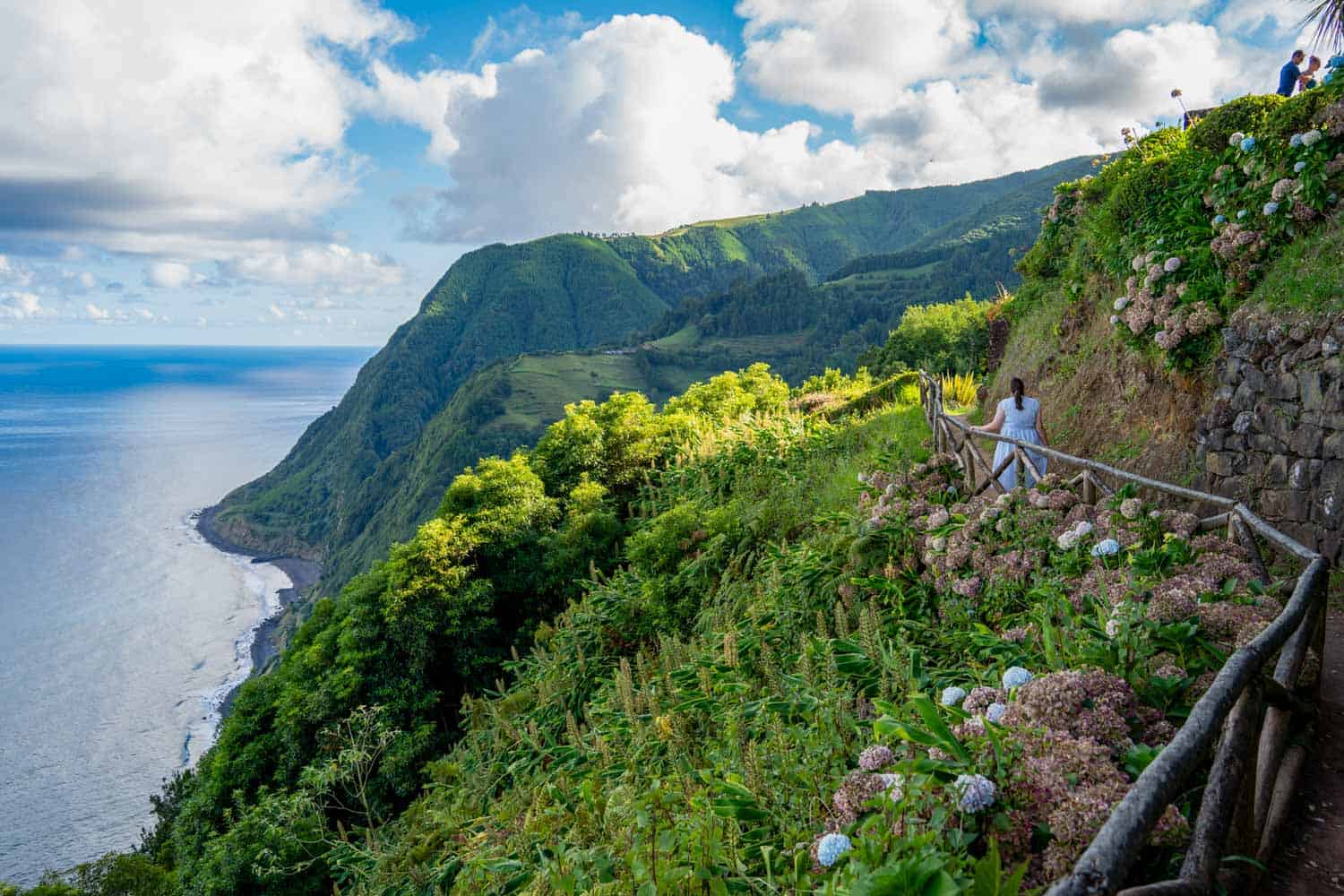10 Essential Things to Know Before Traveling to the Azores Islands

There's this magical chain of islands in the North Atlantic ocean known for dramatic landscapes of blue-green lakes, steaming hot springs, and rolling green hills dotted with hydrangea bushes. Some people call this archipelago “the Hawaii of Europe” – but I would just call them the Azores.
The Azores are a group of 9 volcanic islands in the North Atlantic Ocean, located roughly 870 miles (1400 kilometers) west of Portugal. These islands are technically Portuguese, but the Azores feel worlds away from Lisbon or Porto or even the Algarve.
The largest and most populated island in the Azores is São Miguel, and this is where I visited on my first trip. (I say first, because there will definitely be more!) And after planning and taking that trip, I realized that many people know nothing at all about the Azores.


So I'm here to spill the tea (something you'll also find here!) on what you need to know before going to the Azores yourself.
Know before you go: 10 Azores facts + tips
1. The Azores are part of Portugal
The Azores islands are an autonomous region associated with Portugal (their official name is Região Autónoma dos Açores). The islands are tied to Portugal politically, but the Azores have their own government, including their own President.
With the links to Portugal, most people in the Azores speak Portuguese. Many people speak at least a little bit of English, too (we did not have any issues as tourists who are only fluent in English), but it doesn't hurt to learn at least a few words of Portuguese for your trip.

A few easy phrases you can use to show you've made some effort:
- Hello – Olá
- Good morning – Bom dia (pronounced closer to “bonn dee-uh“)
- Good night – Boa noite (pronounced kind of like “bwoah noyt”)
- Bye – Tchau
- Please – Por favor
- Thank you – Obrigado (if you're a man), Obrigada (if you're a woman)
- Do you speak English? – Fala inlgês?
2. There are multiple islands
The cool thing about the Azores is that each and every island is a little bit different! The 9 islands in the Azores are:
- São Miguel – The largest and most populated island, this island is known for its lakes, geothermal activity, and food.
- Terceira – The second-most-popular (and second-most-populous) island, known for the first designated city in the Azores (Angra do Heroísmo, which is also a UNESCO World Heritage Site), along with hiking and festivals.
- São Jorge – A long skinny island in the central Azores nicknamed “The Dragon,” this island is known for is views, villages, and cheese. It's also home to a coffee plantation.
- Pico – The youngest island and home to Portugal's highest mountain. It's known for its volcanic landscape, whale watching, and even vineyards!
- Faial – The first inhabited island in the Azores, known for its hydrangeas, volcanic landscape, and town of Horta.
- Graciosa – A quiet central island that is also a UNESCO World Biosphere Reserve.
- Flores – A very green, nature-centric island known for its summer flowers and waterfalls.
- Santa Maria – The southernmost island that has a warmer, drier climate. It has some great hiking and beaches.
- Corvo – Smallest and most remote island with just 400 inhabitants. Popular for bird watching.

The islands aren't particularly close together, though; to get from São Miguel to any of the other islands (like Terceira or Pico or Flores), for example, you have to take an inter-island flight with SATA/Azores Airlines. The only islands you can visit easily by ferry are the Ilhas Triangulo, or Triangle of Islands, which are Pico, Faial, and São Jorge in the central Azores.
This means that, if you want to visit multiple islands on your Azores trip, you need to allow enough transit time!
3. The Azores are easy to get to
When most people hear “remote island chain in the middle of the Atlantic,” they probably assume it's hard to get to. But good news! It's actually not that difficult to get to the Azores.
There are multiple daily flights to several Azores islands from Porto and Lisbon, and also daily direct flights to Ponta Delgada (PDL) on São Miguel from other big European cities like Paris, London, Frankfurt, Brussels, Madrid, Milan, and more. AND there are daily direct flights from US cities like Boston and New York.
There are also direct international flights to the island of Terceira.

The main airline flying to and within the Azores is SATA/Azores Airlines, but you can also find flights on TAP Air Portugal and Ryanair in Europe, and United Airlines from the US. (My husband Elliot and I flew from Newark direct to Ponta Delgada, which only takes about 5 hours.)
As the Azores become even more popular, I expect that more direct flights will be added in the coming years.
4. Renting a car is the best way to get around
Once you get TO the Azores, it's important to know that renting a car is the best way to get around, unless you want to book a multi-day guided tour.
Even on São Miguel, the biggest island in the Azores, there's not really a lot of public transit options. Taxis exist, yes, but if you want to see all the corners of the island, you're going to need your own wheels.
The good news is that the roads on most of the islands (and especially on the bigger ones like São Miguel) are pretty well-maintained and easy to navigate. In fact, driving on São Miguel could not be easier! In the Azores (like the rest of Portugal), they drive on the right, so my US and Canadian friends can breathe a sign of relief.

You can rent cars on all the islands in the Azores – just book in advance, since there are a finite number of available cars on each island.
(And if you do want to book a tour instead, this one by Collette visits multiple islands plus Lisbon.)
5. This is not Hawaii
Okay, so you WILL find pineapples and high humidity levels in the Azores. And these islands were also formed by volcanoes. But that's honestly where the direct similarities to Hawaii end.
Even though some people call the Azores “the Hawaii of Europe,” the two sets of islands are honestly quite different, especially when it comes to the weather and landscape.

While Hawaii is hot and tropical, the Azores are more temperate and mild in comparison. The weather in the Azores does change with the seasons (unlike in Hawaii), with winter temperatures averaging around 55-60 degrees F, and summer temps averaging from 70-80 degrees F.
The landscapes are also quite different. In Hawaii, you expect to find palm trees and beautiful white and gold beaches. But in the Azores, you're more likely to find rolling green farmland more akin to Ireland, plus black sand and lava rock beaches.
6. The Azores aren't a beach vacation
Speaking of beaches… the Azores really isn't regarded as a beach destination. Sure, there ARE beaches, and many of them are beautiful. But they often aren't super accessible, and because of the milder climate, the water isn't always warm.
Most of the islands in the Azores have black sand or black lava rock beaches, too, which aren't always the most conducive to sunbathing (though plenty of people still do it!).

7. Be ready to be outdoors
Many people plan trips to the Azores strictly to hike. And while you don't HAVE to hike at all to enjoy a trip to the Azores, it's still helpful to come prepared to be outdoors and active. Why? Because most of the top things to do in the Azores involve at least mild outdoor activity!
Some of the non-hiking things we did included visiting wind-swept viewpoints, walking through a tea plantation, soaking in thermal baths, taking a boat trip, visiting fumaroles, strolling through parks and gardens, and watching beach sunsets. We even ate a few of our meals outdoors now that I think about it.
The Azores islands are mostly known for their beautiful landscapes, and to fully appreciate them you're going to have to spend most of your time outside.

8. Prep for all the weather
Since you're likely to be spending lots of time outdoors, know that you need to be prepared for all types of weather in the Azores.
Like most island destinations in the world – and especially island destinations that are far out in the middle of the ocean – the weather can and does change rapidly in the Azores. Pack for your trip based on the weather forecast temperature-wise (since that can vary a little bit depending on when you're going), but then always be prepared to encounter sun, clouds, wind, rain, and humidity all in the same day, sometimes in quick succession.

Elliot and I visited the Azores in September, and while the forecast was for mostly sunny weather during our stay, we were glad on more than one occasion to have rain coats with us in the car.
9. It's not built for mass tourism
The main economy in the Azores is driven by agriculture (dairy farming and livestock farming) and fishing. Tourism comes in after all those things as a way that people make money.
I visited the largest and most-populated island in the Azores (Sao Miguel), and even it is not really geared towards mass tourism. In fact, I imagine that some spots on the island might struggle if tourism grows much more. For example, when we visited the Gorreana Tea Plantation (the only tea plantation in Europe), it was almost impossible to get down the narrow one-way driveway because of big tour buses trying to squeeze past cars parked along the sides of the bushes.

There are some “main” tourist spots on every island, and the Azores are by no means a “secret,” especially not for European travelers. But this isn't a party destination, nor is it a place where you'll currently find tons of huge resort hotels or 4-lane highways.
Even being the biggest island, Sao Miguel still feels quite rural and local outside of the few main attractions. You can still stumble across more local bars and restaurants than ones built for tourists; you'll find little houses and bowls of food set out for the local cats at almost all of the scenic viewpoints; and you can visit just about any beach without anyone trying to sell you anything.
Help the Azores keep this vibe by being a good tourist. Spend your money locally when you can; clean up after yourself; stay on designated trails; and don't be a loud and entitled asshole anywhere.

10. You need to book ahead
Even though YOU may not know much about traveling to the Azores islands, that doesn't mean that other people haven't heard of them. The Azores do have a high season for tourism (June-August officially, but May and September can also be busy), and they are mostly made up of relatively small towns. (The largest city in the whole island group, Ponta Delgada, only has a population of about 68,000.)
Even if the Azores don't see the amount of tourists that really popular destinations do, the smaller inventory of places to stay and cars to rent means that those things absolutely can get booked up during the high season. If you're planning a summer trip, it's not a bad idea to pre-book hotels and rental cars months in advance if possible.
We visited Sao Miguel in September, and even though it was edging toward shoulder season then, I still found many hotels completely booked out by the time I started looking in July. And if you're visiting smaller islands with even fewer accommodation options, you'll want to plan even further in advance.

Before you even book your flights to the Azores in the summer, I would do a quick search for hotel and rental car availability, just to make sure things are available for your dates. (They should be, but what a terrible surprise that would be if you booked non-refundable flights only to find all the good hotels already filled up, or no affordable cars available to rent.)
It's a good idea to make dinner reservations at popular restaurants, too, especially in Ponta Delgada.
(Having said all this, though, it honestly did not feel “busy” on Sao Miguel at all, other than at the tea plantation.)
Now that you're armed with this Azores knowledge, you should be able to approach planning your own trip a little more confidently. It's an excellent destination, and I know I'll be visiting again.
Have you ever been to the Azores? If not, are you ready to plan a trip now?
You might also like…
Here's more Portugal content for you:
- 3 Days in Lisbon, Portugal: The Ultimate Lisbon Itinerary for Your First Visit
- How to Plan an Epic Day Trip to Sintra from Lisbon
- 2 Days in Porto: What to Do in Porto, Portugal on Your First Visit
- Is Taking a Douro Valley Tour from Porto Worth It? (Spoiler: Yes!)
- A Fantastic 3 Days in Lagos, Portugal Itinerary (Without a Car)
- The Perfect 10-Days in Portugal Itinerary (Without a Car)

Amanda Williams is the award-winning blogger behind A Dangerous Business Travel Blog. She has traveled to more than 60 countries on 6 continents from her home base in Ohio, specializing in experiential and thoughtful travel through the US, Europe, and rest of the world. Amanda only shares tips based on her personal experiences and places she's actually traveled!










This was such a helpful and informative post! I love how you gave a great mix of practical tips and insights into the Azores’ unique charm. I’ll definitely keep the car rental and weather prep tips in mind. Can’t wait to visit these stunning islands!
I love that despite their growing popularity, the islands have maintained a local and authentic vibe. Your point about supporting the local economy and respecting the environment is so important—those little steps go such a long way in preserving the charm of places like this. I haven’t been yet, but this post has me even more excited to start planning a visit. Thanks for the inspiration!
Thanks for reading! I hope the vibe of the Azores can be preserved for many years to come, as it’s a special spot!
We went to the Azores (Sao Miguel) when we took a transatlantic cruise from Fort Lauderdale, FL, to Barcelona, Spain. It’s beautiful and we would love to go back and visit it more. It definitely has a Hawaii in the Atlantic feel to it, but much more European. I have recommended it to many people that are considering something a little different, but very comfortable.
It definitely is a unique spot, and I’ll be recommending it now too!